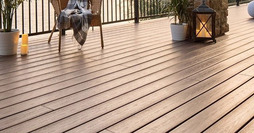
Laminated Wooden Flooring
Laminated wooden flooring, often simply referred to as laminate flooring, is a popular and cost-effective flooring option used in both residential and commercial settings. It is a versatile alternative to traditional hardwood flooring and offers several advantages:



Affordability: Laminate flooring is generally more budget-friendly than hardwood or engineered wooden flooring. It provides a wood-like appearance at a fraction of the cost.
Durability: Laminate flooring is highly durable and resistant to scratches, stains, and fading. This makes it a good choice for high-traffic areas and homes with pets or children
Easy Installation: Laminate flooring is designed with a click-and-lock installation system, which means it can be installed without the need for glue or nails. This makes it a popular choice for DIY enthusiasts.
Limited Refinishing: Unlike hardwood floors, which can be sanded and refinished multiple times, laminate flooring cannot be refinished. Once it's scratched or damaged, it usually needs to be replaced.
Low Maintenance: Cleaning and maintaining laminate flooring is relatively easy. Regular sweeping and occasional mopping with a damp cloth are usually sufficient to keep it looking good.
Variety of Designs:Laminate flooring comes in a wide range of designs, including various wooden grain patterns, colors, and textures. Some laminates can even mimic the look of stone or tile.
Moisture Resistance:While laminate flooring is not as water-resistant as some other options like vinyl or tile, many modern laminate products have water-resistant or waterproof coatings that provide some protection against moisture.
Laminated Wooden Flooring is a practical and cost-effective choice for many homeowners and businesses looking for the aesthetic appeal of wooden flooring without the high cost and maintenance requirements. However, it's important to choose high-quality laminate products and follow proper installation and maintenance guidelines to ensure its longevity and performance.
Enquiry Now











